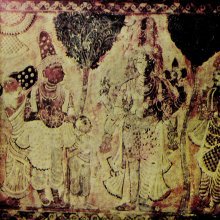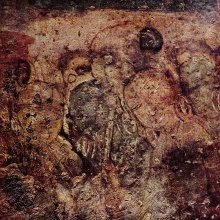Mangalesha, Maṅgaleśa: 1 definition
Introduction:
Mangalesha means something in the history of ancient India. If you want to know the exact meaning, history, etymology or English translation of this term then check out the descriptions on this page. Add your comment or reference to a book if you want to contribute to this summary article.
The Sanskrit term Maṅgaleśa can be transliterated into English as Mangalesa or Mangalesha, using the IAST transliteration scheme (?).
Images (photo gallery)
India history and geography
Source: Archaeological Survey of India: Śaiva monuments at PaṭṭadakalMaṅgaleśa (मङ्गलेश) is one of the two sons of Pulakeśin I, the other being Kīrtivarman. On Pulakeśin’s death Kīrtivarman came to the throne (566-96). Kīrtivarman requested Maṅgaleśa to look after the kingdom till his son (Pulikeśin II ) come of age. Maṅgaleśa (596-609) shouldered the burden of the kingdom but later became ambitious. He became so ambitious that he wished to have the throne for his own son.

The history of India traces the identification of countries, villages, towns and other regions of India, as well as mythology, zoology, royal dynasties, rulers, tribes, local festivities and traditions and regional languages. Ancient India enjoyed religious freedom and encourages the path of Dharma, a concept common to Buddhism, Hinduism, and Jainism.
See also (Relevant definitions)
Full-text: Aryapura, Ravikirti, Kirtivarman, Indukanti, Durlabhadevi, Mahendravarman, Mankalecan, Pulakeshin, Barhaspatyamana, Samvatsara.
Relevant text
Search found 5 books and stories containing Mangalesha, Maṅgaleśa, Mangalesa; (plurals include: Mangaleshas, Maṅgaleśas, Mangalesas). You can also click to the full overview containing English textual excerpts. Below are direct links for the most relevant articles:
Vasudevavijaya of Vasudeva (Study) (by Sajitha. A)
Vibhaktivilāsa of Maṅgaleśa < [Chapter 1 - Śāstrakāvyas—A Brief Survey]
Bhaṭṭikāvya of Bhaṭṭi < [Chapter 1 - Śāstrakāvyas—A Brief Survey]
Durvinita and Vikramaditya I < [January, 1928]
The Shiva Purana (by J. L. Shastri)
Chapter 5 - The death of the Brahmin lady and the greatness of Nandikeśvara < [Section 4 - Koṭirudra-Saṃhitā]
Pallava period (Social and Cultural History) (by S. Krishnamurthy)
The Ruling elite < [Chapter 3 - Socio-Religious Life]
The Later or the Imperial Pallavas < [Chapter 1 - Introduction]
Complete works of Swami Abhedananda (by Swami Prajnanananda)
Appendix 2 - Indian Art in all its Phases < [Discourse 1 - India and Her People]

